Public Participation in Smart-City Governance: A Qualitative Content Analysis of Public Comments in Urban China
Abstract
1. Introduction
2. Literature Review
2.1. E-Governance and E-Participation in Smart Cities
2.2. Content Analysis in the Era of Big Data
2.3. Rationale of Urban Governance and Public Participation in China
3. Study Context, Data and Methods
3.1. Study Context
3.2. Data Collection and Manipulation
3.3. Methodology
4. Results
4.1. Statistical and Spatial Distribution of Urban Problems
4.2. Spatial Relationship of Urban Problems
4.3. Associative Factors of Urban Problems to Guide Urban Governance
5. Discussion and Conclusions
Author Contributions
Funding
Acknowledgments
Conflicts of Interest
References
- Viale Pereira, G.; Cunha, M.A.; Lampoltshammer, T.J.; Parycek, P.; Testa, M.G. Increasing collaboration and participation in smart city governance: A cross–case analysis of smart city initiatives. Inf. Technol. Dev. 2017, 23, 526–553. [Google Scholar] [CrossRef]
- Jin, J.; Gubbi, J.; Marusic, S.; Palaniswami, M. An information framework for creating a smart city through internet of things. IEEE Internet Things J. 2014, 1, 112–121. [Google Scholar] [CrossRef]
- Perera, C.; Zaslavsky, A.; Christen, P.; Georgakopoulos, D. Sensing as a service model for smart cities supported by internet of things. Trans. Emerg. Telecommun. Technol. 2014, 25, 81–93. [Google Scholar] [CrossRef]
- Zanella, A.; Bui, N.; Castellani, A.; Vangelista, L.; Zorzi, M. Internet of things for smart cities. IEEE Internet Things J. 2014, 1, 22–32. [Google Scholar] [CrossRef]
- Angelidou, M. Smart city policies: A spatial approach. Cities 2014, 41, S3–S11. [Google Scholar] [CrossRef]
- Lombardi, P.; Giordano, S.; Farouh, H.; Yousef, W. Modelling the smart city performance. Innov. Eur. 2012, 25, 137–149. [Google Scholar] [CrossRef]
- Poorthuis, A.; Zook, M.; Taylor Shelton, M.G.; Stephens, M. Using geotagged digital social datain geographic research. In Key Methods in Geography; Clifford, N., Cope, M., Gillespie, T., French, S., Eds.; SAGE: London, UK, 2016; Volume 16, pp. 248–269. [Google Scholar]
- Bates, D.W.; Saria, S.; Ohno-Machado, L.; Shah, A.; Escobar, G. Big data in health care: Using analytics to identify and manage high-risk and high-cost patients. Health Aff. 2014, 33, 1123–1131. [Google Scholar] [CrossRef] [PubMed]
- Jagadish, H.V.; Gehrke, J.; Labrinidis, A.; Papakonstantinou, Y.; Patel, J.M.; Ramakrishnan, R.; Shahabi, C. Big data and its technical challenges. Commun. ACM 2014, 57, 86–94. [Google Scholar] [CrossRef]
- Song, M.L.; Fisher, R.; Wang, J.L.; Cui, L.B. Environmental performance evaluation with big data: Theories and methods. Ann. Oper. Res. 2018, 270, 459–472. [Google Scholar] [CrossRef]
- Li, S. Research on Public Participation and Government Response Based on Big Data Mining on the Internet Political Platform; Huazhong University of Science and Technology: Wuhan, China, 2019. (In Chinese) [Google Scholar]
- Zhang, Y. Grade structure of public planning values: Based on content analysis of public messages in the field of urban planning. City Plan. Rev. 2019, 43, 108–116. (In Chinese) [Google Scholar]
- Pløger, J. Public participation and the art of governance. Environ. Plan. B Plan. Des. 2001, 28, 219–241. [Google Scholar] [CrossRef]
- Batty, M.; Axhausen, K.W.; Giannotti, F.; Pozdnoukhov, A.; Bazzani, A.; Wachowicz, M.; Portugali, Y. Smart cities of the future. Eur. Phys. J. Spec. Top. 2012, 214, 481–518. [Google Scholar] [CrossRef]
- Albino, V.; Berardi, U.; Dangelico, R.M. Smart cities: Definitions, dimensions, performance, and initiatives. J. Urban Technol. 2015, 22, 3–21. [Google Scholar] [CrossRef]
- Angelidou, M.; Psaltoglou, A.; Komninos, N.; Kakderi, C.; Tsarchopoulos, P.; Panori, A. Enhancing sustainable urban development through smart city applications. J. Sci. Technol. Policy Manag. 2018, 9, 146–169. [Google Scholar] [CrossRef]
- Azzari, M.; Azzari, M.; Garau, C.; Nesi, P.; Paolucci, M.; Zamperlin, P. Smart city governance strategies to better move towards a smart urbanism. In International Conference on Computational Science and Its Applications; Springer: Cham, Switzerland, 2018; pp. 639–653. [Google Scholar]
- Chourabi, H.; Nam, T.; Walker, S.; Gil-Garcia, J.R.; Mellouli, S.; Nahon, K.; Scholl, H.J. Understanding smart cities: An integrative framework. In Proceedings of the 45th Hawaii International Conference on System Sciences, Maui, HI, USA, 4–7 January 2012; pp. 2289–2297. [Google Scholar]
- Ansell, C.; Gash, A. Collaborative governance in theory and practice. J. Public Adm. Res. Theory 2008, 18, 543–571. [Google Scholar] [CrossRef]
- Misuraca, G.; Alfano, G.; Viscusi, G. Interoperability challenges for ICT-enabled governance: Towards a pan-European conceptual framework. J. Appl. Electron. Commer. Res. 2011, 6, 95–111. [Google Scholar] [CrossRef][Green Version]
- Ju, J.; Liu, L.; Feng, Y. Citizen-centered big data analysis-driven governance intelligence framework for smart cities. Telecommun. Policy 2018, 42, 881–896. [Google Scholar] [CrossRef]
- Abella, A.; Ortiz-de-Urbina-Criado, M.; De Pablos-Heredero, C. Information reuse in smart cities ecosystems. Prof. Inf. 2015, 24, 838–844. [Google Scholar] [CrossRef]
- Al Nuaimi, E.; Al Neyadi, H.; Mohamed, N.; Al-Jaroodi, J. Applications of big data to smart cities. J. Internet Serv. Appl. 2015, 6, 25. [Google Scholar] [CrossRef]
- Kitchin, R. Big Data, new epistemologies and paradigm shifts. Big Data Soc. 2014, 1, 2053951714528481. [Google Scholar] [CrossRef]
- Maloney-Krichmar, D.; Preece, J. A multilevel analysis of sociability, usability, and community dynamics in an online health community. ACM Trans. Comput. Hum. Interact. (Tochi) 2005, 12, 201–232. [Google Scholar] [CrossRef]
- Mayring, P. Qualitative content analysis. Companion Qual. Res. 2004, 1, 159–176. [Google Scholar]
- Elo, S.; Kyngäs, H. The qualitative content analysis process. J. Adv. Nurs. 2008, 62, 107–115. [Google Scholar] [CrossRef] [PubMed]
- Crowley, B.P.; Delfico, J.F. Program evaluation and methodology division. In Content Analysis: A Methodology for Structuring and Analyzing Written Material; United States General Accounting Office (GAO): Washington, DC, USA, 1996. [Google Scholar]
- Schreier, M. Qualitative Content Analysis in Practice; Sage Publisher: London, UK, 2012. [Google Scholar]
- Liu, Y.; Liu, D.; Chen, Y. Research on sentiment tendency and evolution of public opinions in social networks of smart city. Complexity 2020, 2020. [Google Scholar] [CrossRef]
- Wang, X.; Wei, F.; Liu, X.; Zhou, M.; Zhang, M. Topic sentiment analysis in twitter: A graph–based hashtag sentiment classification approach. In Proceedings of the 20th ACM International Conference on Information and Knowledge Management, Scotland, UK, 24–28 October 2011; pp. 1031–1040. [Google Scholar]
- Nodarakis, N.; Sioutas, S.; Tsakalidis, A.K.; Tzimas, G. Large scale sentiment analysis on Twitter with spark. In Proceedings of the EDBT/ICDT Workshops, Bordeaux, France, 15 March 2016; pp. 1–8. [Google Scholar]
- Kanavos, A.; Nodarakis, N.; Sioutas, S.; Tsakalidis, A.; Tsolis, D.; Tzimas, G. Large scale implementations for twitter sentiment classification. Algorithms 2017, 10, 33. [Google Scholar] [CrossRef]
- Enserink, B.; Koppenjan, J. Public participation in China: Sustainable urbanization and governance. Manag. Environ. Qual. Int. J. 2007, 18, 459–474. [Google Scholar] [CrossRef]
- Wu, F. Housing privatization and the return of the state: Changing governance in China. Urban Geogr. 2018, 39, 1177–1194. [Google Scholar] [CrossRef]
- Cheshire, C.; Antin, J.; Cook, K.S.; Churchill, E. General and familiar trust in websites. Knowl. Technol. Policy 2010, 23, 311–331. [Google Scholar] [CrossRef]
- Chen, S.C.; Webster, C.J. Homeowners associations, collective action and the costs of private governance. Hous. Stud. 2005, 20, 205–220. [Google Scholar] [CrossRef]
- Csefalvay, Z. Gated communities for security or prestige? A public choice approach and the case of Budapest. Int. J. Urban Reg. Res. 2011, 35, 735–752. [Google Scholar] [CrossRef]
- Lu, T.; Zhang, F.; Wu, F. Place attachment in gated neighbourhoods in China: Evidence from Wenzhou. Geoforum 2018, 92, 144–151. [Google Scholar] [CrossRef]
- Shen, J.; Wu, F. The suburb as a space of capital accumulation: The development of new towns in Shanghai, China. Antipode 2017, 49, 761–780. [Google Scholar] [CrossRef]
- Wu, F. Rediscovering the ‘gate’ under market transition: From work-unit compounds to commodity housing enclaves. Hous. Stud. 2005, 20, 235–254. [Google Scholar] [CrossRef]
- McGuirk, P.; Dowling, R.; Gibson, C.R.; Iveson, K.; Mee, K. Urban Vitality, Culture and the Public Realm; University of Wollongong: Dubai, UAE, 2007. [Google Scholar]
- Wang, Y.P.; Wang, Y.; Bramley, G. Chinese housing reform in state-owned enterprises and its impacts on different social groups. Urban Stud. 2005, 42, 1859–1878. [Google Scholar] [CrossRef]
- Atkinson, R.; Blandy, S. Introduction: International perspectives on the new enclavism and the rise of gated communities. Hous. Stud. 2005, 20, 177–186. [Google Scholar] [CrossRef]
- Goodman, R.; Douglas, K. Life in a master planned estate—Community and lifestyle or conflict and liability? Urban Policy Res. 2010, 28, 451–469. [Google Scholar] [CrossRef]
- Breitung, W. Enclave urbanism in China: Attitudes towards gated communities in Guangzhou. Urban Geogr. 2012, 33, 278–294. [Google Scholar] [CrossRef]
- Webster, C. Gated cities of tomorrow. Town Plan. Rev. 2001, 72, 149–170. [Google Scholar] [CrossRef]
- He, S. Homeowner associations and neighborhood governance in Guangzhou, China. Eurasian Geogr. Econ. 2015, 56, 260–284. [Google Scholar] [CrossRef]
- Wuhan Bureau of Statistics. Statistical Bulletin of National Economic and Social Development in Wuhan. 2018. Available online: http://tjj.wuhan.gov.cn/tjfw/tjgb/202001/t20200115_841065.shtml (accessed on 7 September 2020).
- Wuhan Natural Resources and Planning Bureau. Wuhan Land Grade and Benchmark Land Price Standard. 2018. Available online: http://zrzyhgh.wuhan.gov.cn/bsfw_18/tdsc/jzdj/202004/t20200420_1032923.shtml (accessed on 7 September 2020).
- Arctic Monitoring and Assessment Programme (AMAP). Map POI (Point of Interest) Data. 2018. Available online: https://opendata.pku.edu.cn/dataset.xhtml?persistentId=doi:10.18170/DVN/WSXCNM (accessed on 7 September 2020).
- Wuhan Bureau of Statistics. Population Sample Survey of Wuhan. 2015; (Internal sources not available online). [Google Scholar]
- Anselin, L. Local indicators of spatial association—LISA. Geogr. Anal. 1995, 27, 93–115. [Google Scholar] [CrossRef]
- Anselin, L.; Syabri, I.; Kho, Y. GeoDa: An introduction to spatial data analysis. Geogr. Anal. 2006, 38, 5–22. [Google Scholar] [CrossRef]
- Benesty, J.; Chen, J.; Huang, Y.; Cohen, I. Pearson correlation coefficient. In Noise Reduction in Speech Processing; Springer: Berlin/Heidelberg, Germany, 2009; pp. 1–4. [Google Scholar]
- Ward, M.D.; Gleditsch, K.S. Spatial Regression Models; Sage Publications: London, UK, 2018. [Google Scholar]
- Anselin, L. Spatial Econometrics: Methods and Models; Springer Science & Business Media: Berlin, Germany, 2013. [Google Scholar]
- Zhang, X.; Hu, J.; Skitmore, M.; Leung, B.Y. Inner–city urban redevelopment in China metropolises and the emergence of gentrification: Case of Yuexiu, Guangzhou. J. Urban. Plan. Dev. 2014, 140, 05014004. [Google Scholar] [CrossRef]
- Guthrie, D. China and Globalization: The Social, Economic and Political Transformation of Chinese Society; Routledge: New York, NY, USA, 2012. [Google Scholar]
- Gao, Z.; Yin, N.; Tong, X.; Li, D.; Gu, J. Shrinkage under urban growth: A case study of Wuhan city. Trop. Geogr. 2019, 39, 31–38. (In Chinese) [Google Scholar]
- Chang, H.S.; Liao, C.H. Exploring an integrated method for measuring the relative spatial equity in public facilities in the context of urban parks. Cities 2011, 28, 361–371. [Google Scholar] [CrossRef]
- Yang, X.; Long, Y. Opportunities and Limitation of Big Data Application to human and economic geography: The state of the art. Prog. Geogr. 2015, 34, 410–417. (In Chinese) [Google Scholar]
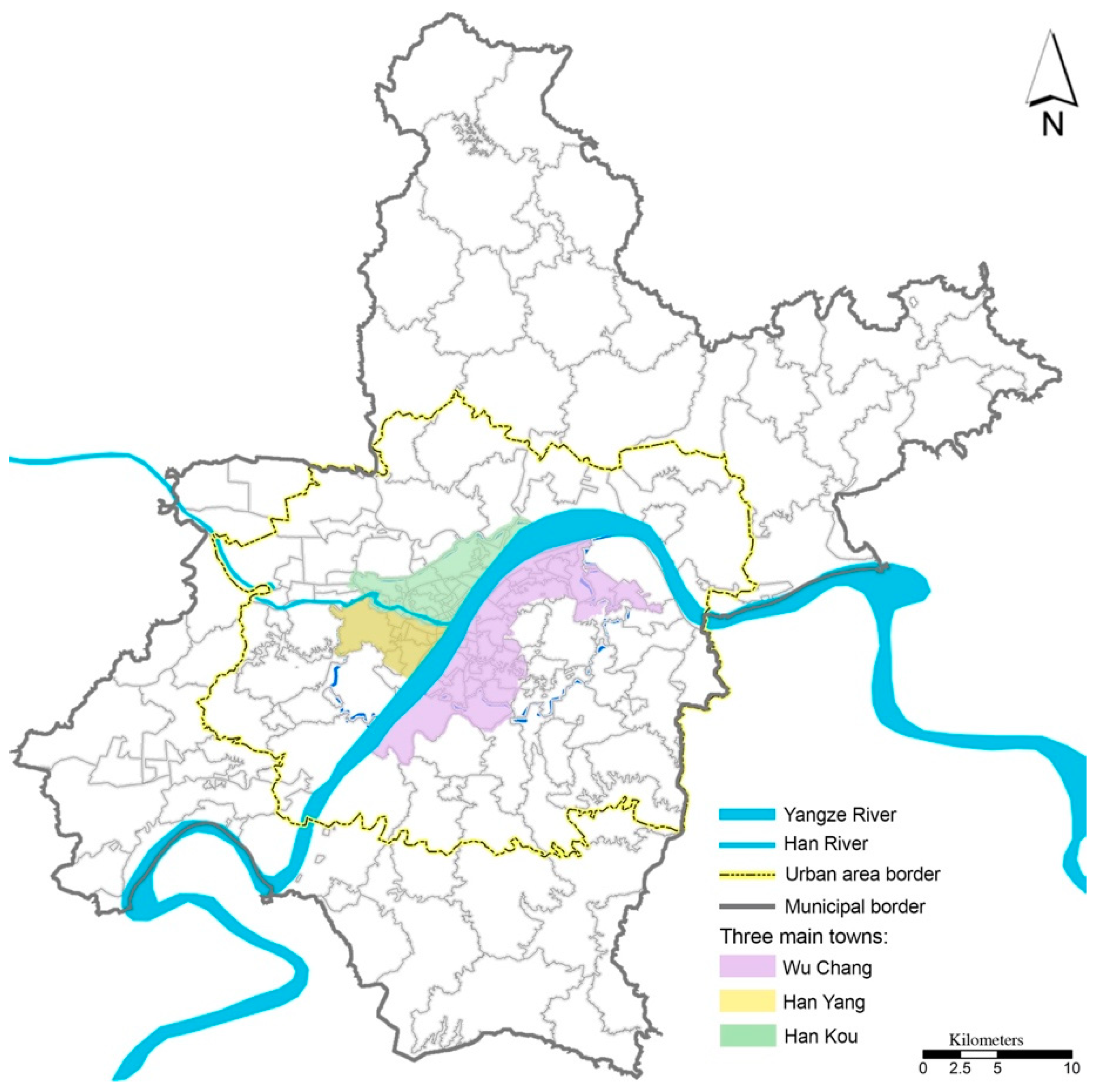

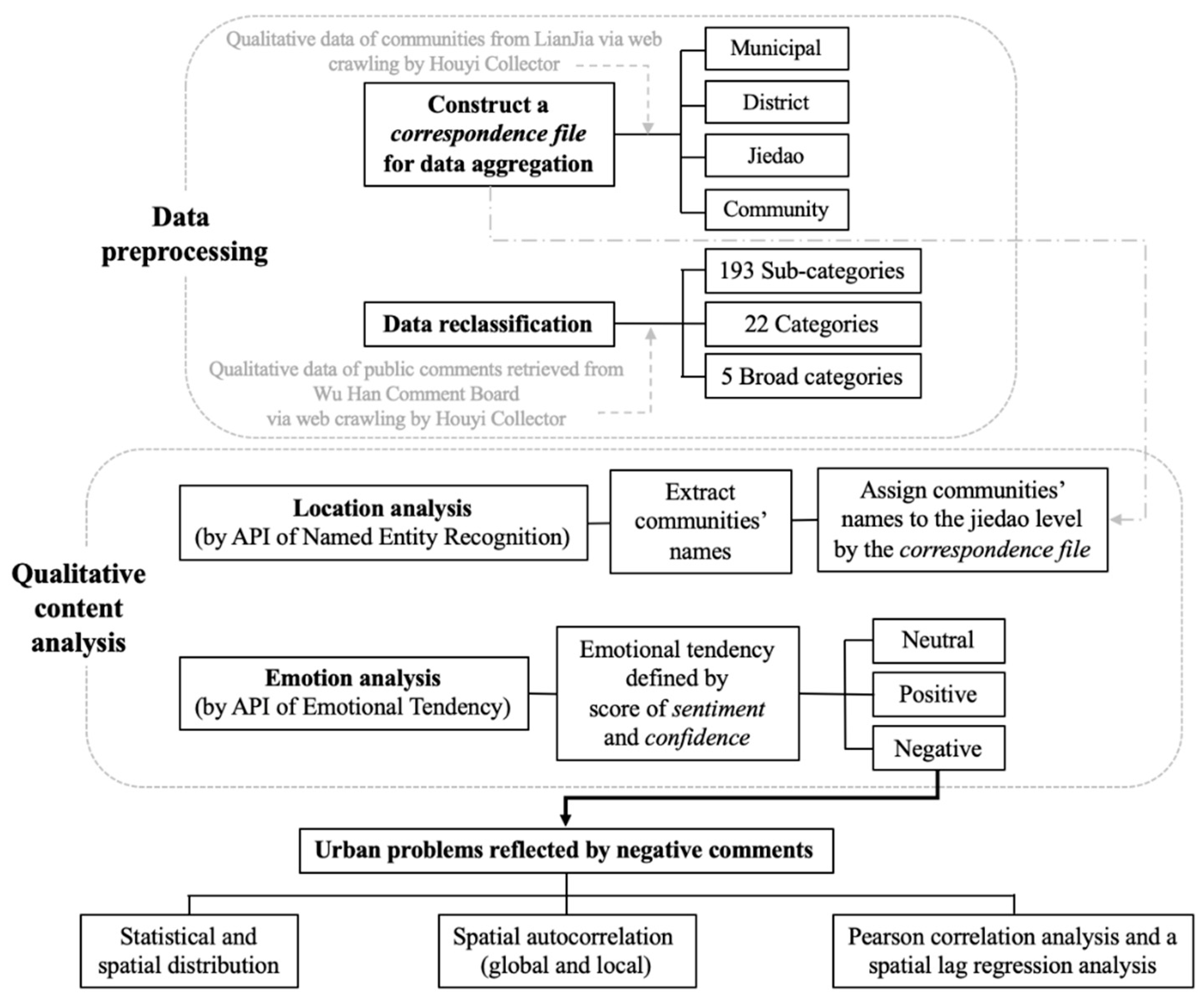
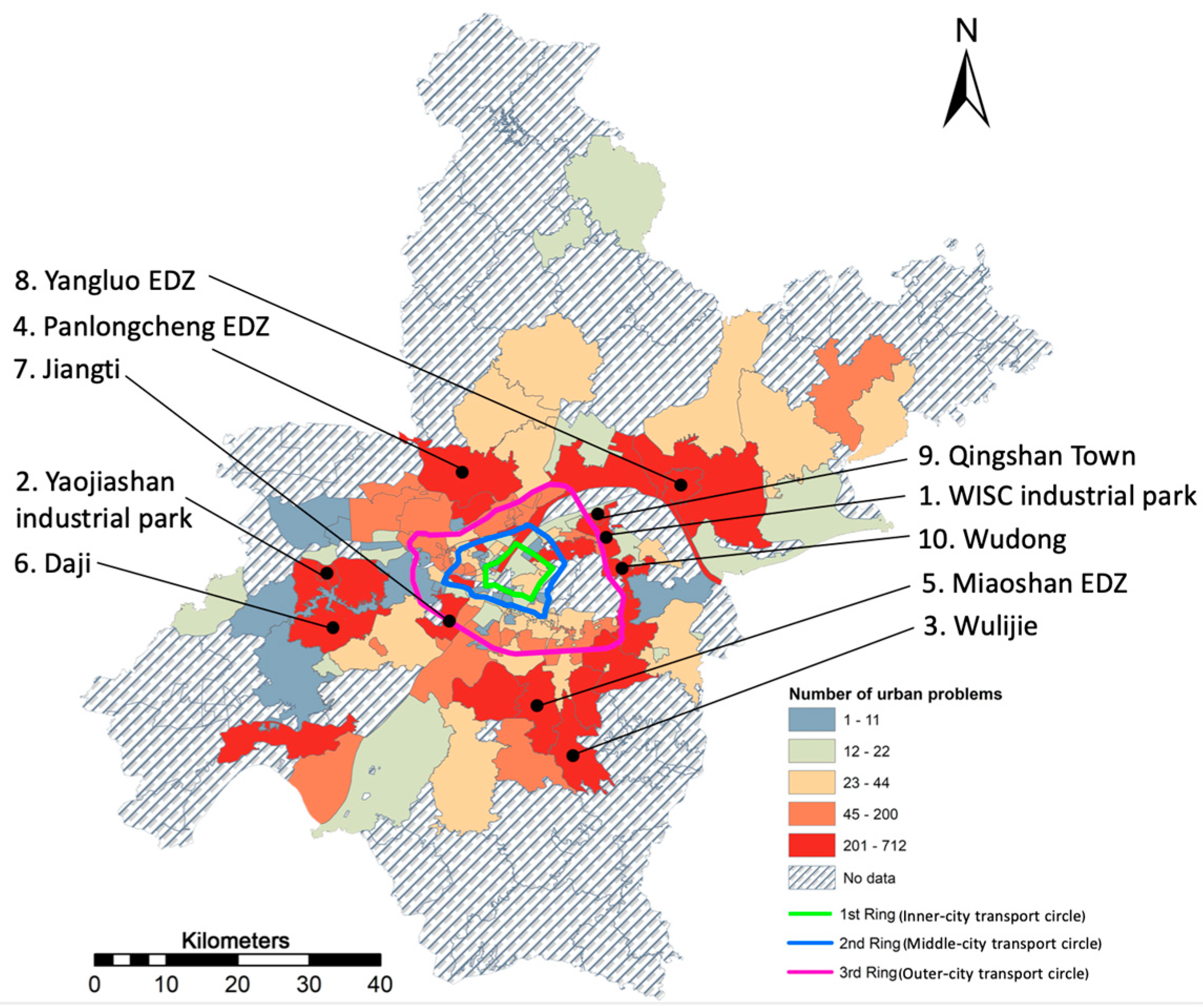

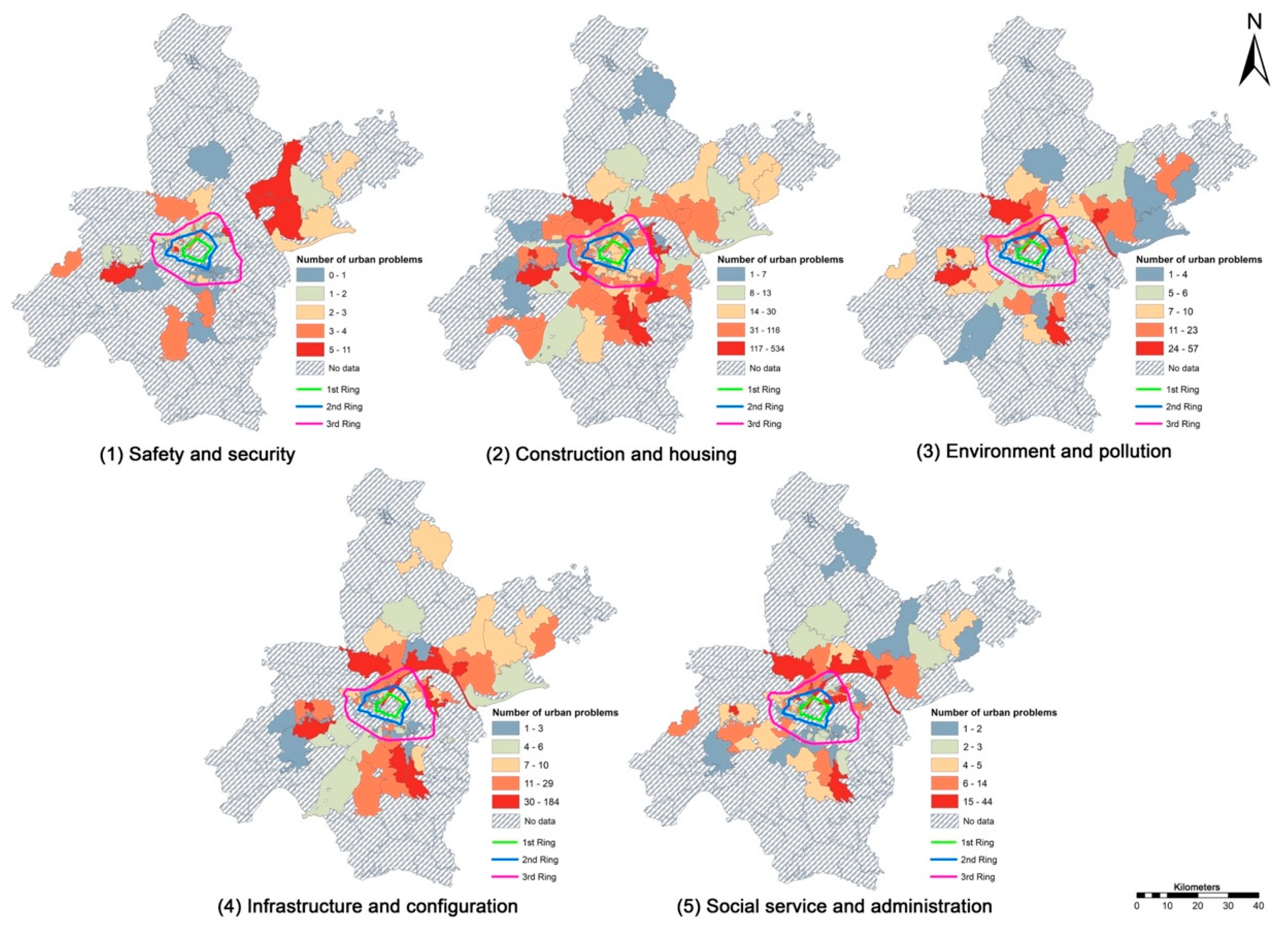
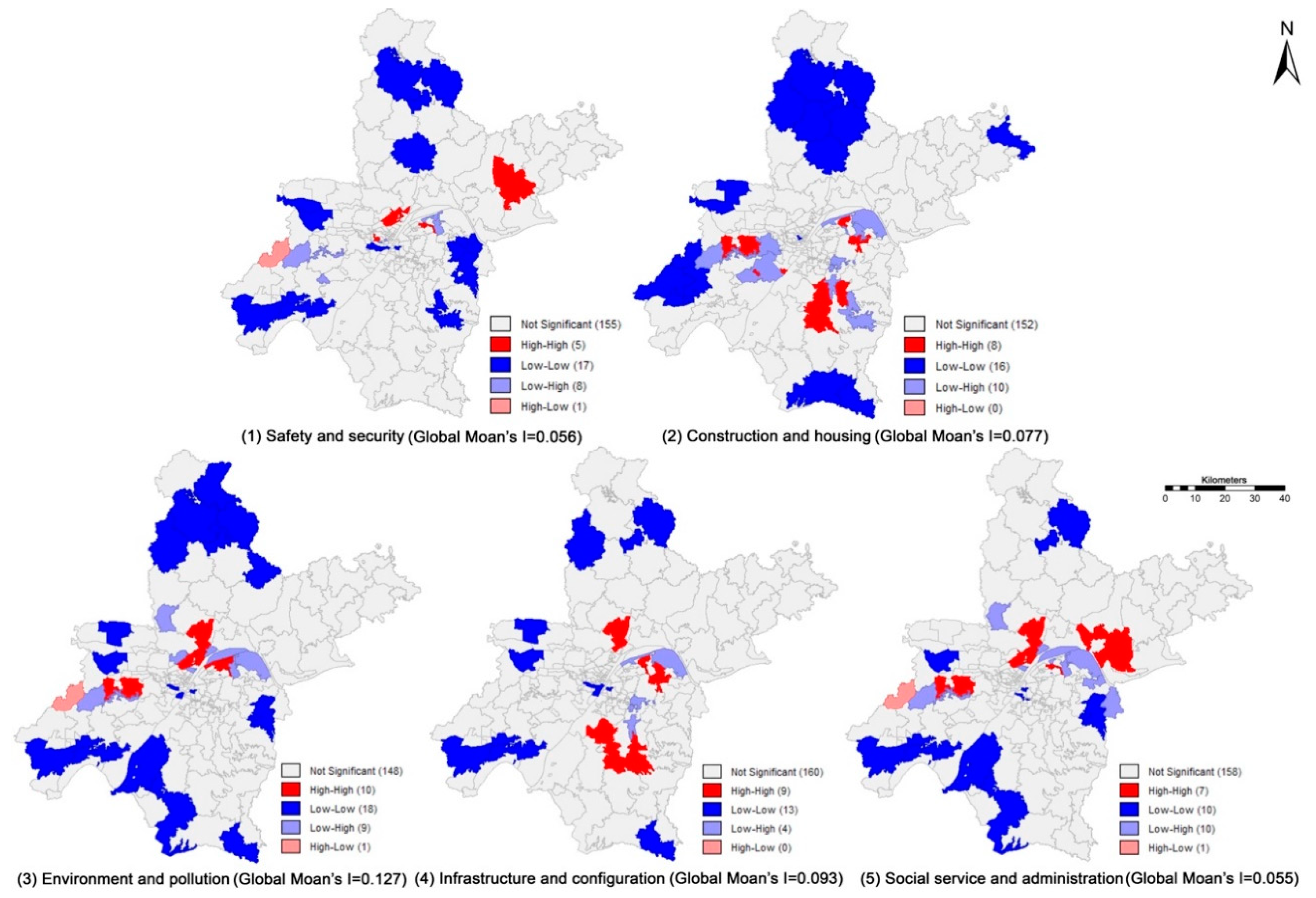
| No. | Variable | Variable | |||||||||||||
|---|---|---|---|---|---|---|---|---|---|---|---|---|---|---|---|
| 1 | 2 | 3 | 4 | 5 | 6 | 7 | 8 | 9 | 10 | 11 | 12 | 13 | 14 | ||
| 1 | Land price | 1 | |||||||||||||
| 2 | Age above 65 | 0.195 | 1 | ||||||||||||
| 3 | Civil facilities | 0.163 | −0.159 | 1 | |||||||||||
| 4 | Traffic | −0.002 | −0.143 | 0.936 | 1 | ||||||||||
| 5 | Commercial | 0.173 | −0.162 | 0.999 | 0.924 | 1 | |||||||||
| 6 | Public | 0.098 | −0.047 | 0.925 | 0.950 | 0.913 | 1 | ||||||||
| 7 | Educational | 0.043 | −0.259 | 0.583 | 0.608 | 0.567 | 0.603 | 1 | |||||||
| 8 | Medical | 0.307 | −0.022 | 0.910 | 0.834 | 0.907 | 0.848 | 0.514 | 1 | ||||||
| 9 | Urban problems | −0.298 | −0.323 | 0.372 | 0.478 | 0.361 | 0.416 | 0.258 | 0.279 | 1 | |||||
| 10 | Category1 | −0.017 | −0.024 | −0.036 | −0.046 | −0.037 | 0.022 | −0.026 | 0.006 | 0.232 | 1 | ||||
| 11 | Category2 | −0.283 | −0.320 | 0.392 | 0.509 | 0.380 | 0.439 | 0.280 | 0.302 | 0.965 | 0.120 | 1 | |||
| 12 | Category3 | −0.143 | −0.171 | −0.038 | −0.030 | −0.037 | −0.026 | −0.096 | −0.040 | 0.586 | 0.512 | 0.440 | 1 | ||
| 13 | Category4 | −0.288 | −0.255 | 0.411 | 0.497 | 0.402 | 0.443 | 0.298 | 0.300 | 0.852 | 0.239 | 0.717 | 0.488 | 1 | |
| 14 | Category5 | −0.163 | −0.218 | −0.054 | −0.030 | −0.054 | −0.035 | −0.097 | −0.067 | 0.664 | 0.360 | 0.515 | 0.845 | 0.610 | 1 |
| Variable | All | Category1 | Category2 | Category3 | Category4 | Category5 |
|---|---|---|---|---|---|---|
| Land price A | −0.196 ** | −0.137 | −0.154 * | −0.36 *** | −0.271 ** | −0.273 ** |
| Age above 65 | −0.287 *** | −0.189 | −0.29 *** | −0.437 *** | −0.187 * | −0.341 *** |
| Civil facilities | 0.393 *** | 0.015 | 0.407 *** | 0.100 | 0.461 *** | 0.114 |
| Traffic | 0.687 ** | −0.033 | 0.827 *** | 0.411 *** | 1.061 ** | 0.471 *** |
| Commercial | −0.508 * | −0.461 ** | −0.649 ** | −0.453 *** | −0.281 | −0.225 |
| Public | 0.234 | 0.721 *** | 0.218 | 0.515 *** | −0.238 | 0.257 ** |
| Educational | −0.122 | −0.237 | −0.146 | −0.311 *** | 0.007 | −0.279 ** |
| Medical | 0.085 | 0.145 | 0.135 | 0.129 | −0.086 | −0.011 |
| Constant B | 204.98 *** | 197.9 *** | 240.06 *** | 219.92 *** | 211.65 *** | 263.56 *** |
| F statistics | 3.984 | 1.056 | 4.587 | 2.923 | 7.769 | 3.370 |
| Model Sig | 0.001 | 0.011 | 0 | 0.01 | 0 | 0.004 |
| R-squared | 0.386 | 0.292 | 0.421 | 0.395 | 0.439 | 0.342 |
| Number | 124 | 44 | 119 | 73 | 76 | 76 |
Publisher’s Note: MDPI stays neutral with regard to jurisdictional claims in published maps and institutional affiliations. |
© 2020 by the authors. Licensee MDPI, Basel, Switzerland. This article is an open access article distributed under the terms and conditions of the Creative Commons Attribution (CC BY) license (http://creativecommons.org/licenses/by/4.0/).
Share and Cite
Gao, Z.; Wang, S.; Gu, J. Public Participation in Smart-City Governance: A Qualitative Content Analysis of Public Comments in Urban China. Sustainability 2020, 12, 8605. https://doi.org/10.3390/su12208605
Gao Z, Wang S, Gu J. Public Participation in Smart-City Governance: A Qualitative Content Analysis of Public Comments in Urban China. Sustainability. 2020; 12(20):8605. https://doi.org/10.3390/su12208605
Chicago/Turabian StyleGao, Zhe, Siqin Wang, and Jiang Gu. 2020. "Public Participation in Smart-City Governance: A Qualitative Content Analysis of Public Comments in Urban China" Sustainability 12, no. 20: 8605. https://doi.org/10.3390/su12208605
APA StyleGao, Z., Wang, S., & Gu, J. (2020). Public Participation in Smart-City Governance: A Qualitative Content Analysis of Public Comments in Urban China. Sustainability, 12(20), 8605. https://doi.org/10.3390/su12208605




